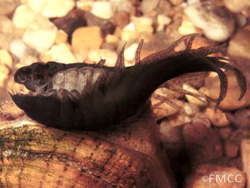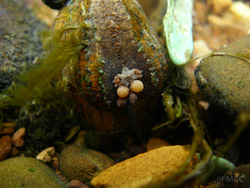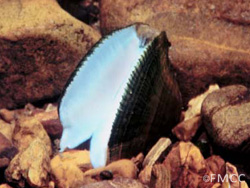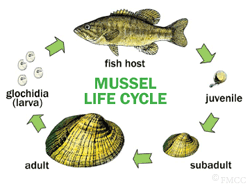Freshwater mussels have a unique life history, requiring the use of fish in the life cycle. Eggs of female mussels are fertilized internally by sperm released by males into the water and taken in during siphoning. The embryos then develop in the gills of the female until becoming mature larvae (called glochidia). Once mature, the female then releases glochidia out into the water, where they must attach and encyst on a suitable host fish for the transformation of larvae to juvenile mussels. The juveniles then excyst and drop from the fish host to begin their lives on the bottom of a river or lake. Many endangered mussels require specific fish hosts to successfully reproduce. Thus, some mussel species produce glochidia in packets (conglutinates) that closely resemble prey of fish, such as worms, insect larvae and pupae, leeches, while other mussel species have an external “lure”, which is modified portion of their mantle. Both conglutinates and mantle lures are used to attract fish hosts and facilitate attachment of glochidia. Depending on the species, mussel glochidia brood in the gills of females during either fall-winter (Bradytictic) or spring-summer (Tachytictic). Bradytictic species typically release their glochidia in late winter, spring and early summer, while tachytictic species release glochidia only in the summer.

Female wavy-reayed lampmussel (Lampsilis fasciola)
displaying mantle-lure.

A female Cumberlandian combshell (Epiblasma brevidens), Clinch River, TN, USA.

Female oyster mussel (Epioblasma capsaeformis) displaying her mantle-pad to attract a fish host, Clinch River, TN, USA.

